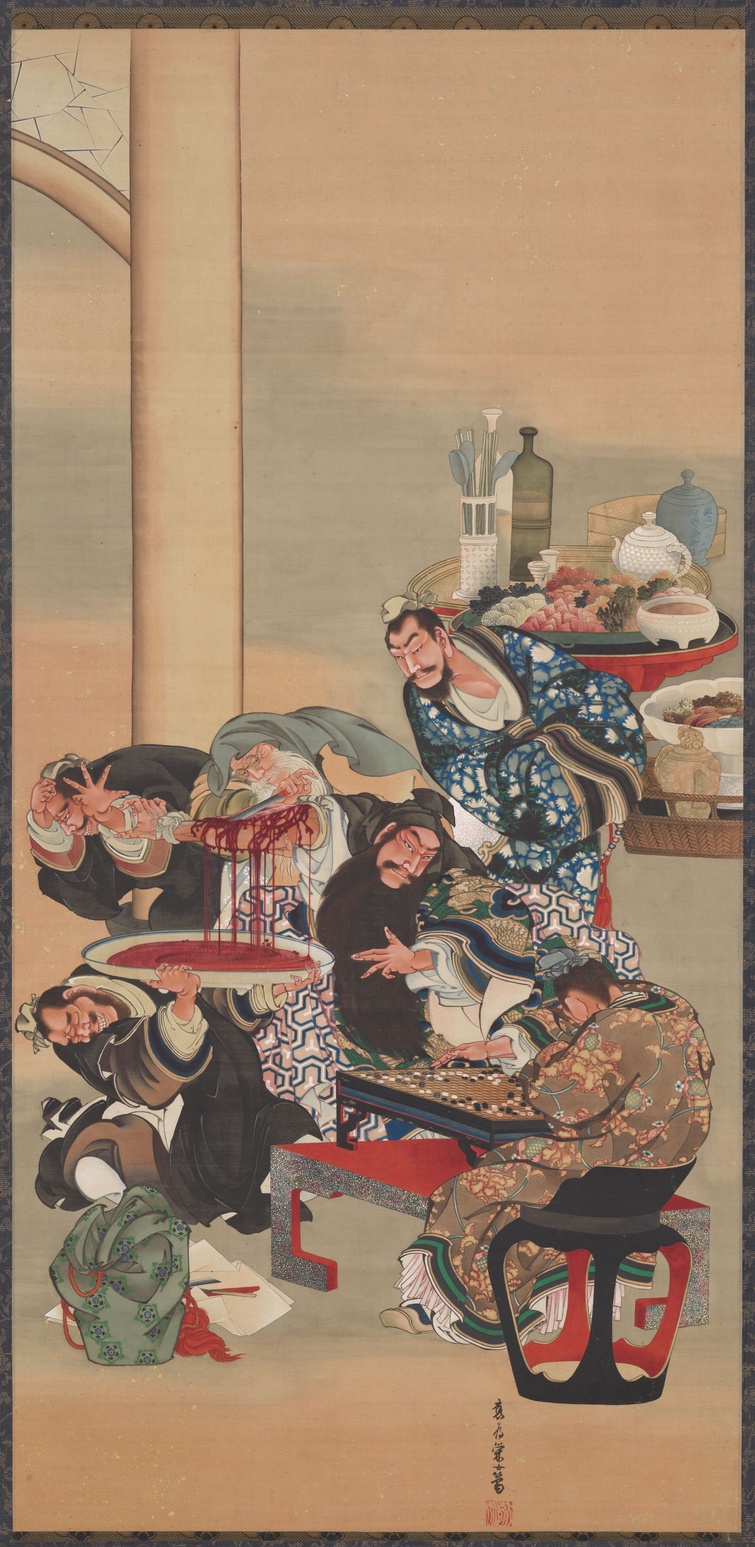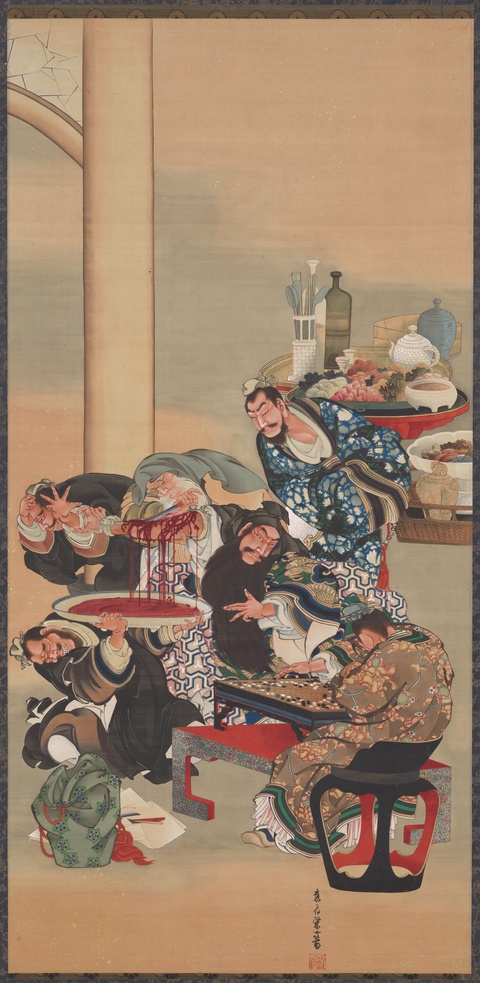Katsushika Ōi: Shadows of Edo
By Max Levin•April 2022•7 Minute Read

Katsushika Ōi, Operating on Guan Yu's Arm, 1840s. Cleveland Museum of Art. Guan Yu bravely undergoes a medical procedure while playing a common board game.
Katsushika Ōi was a gifted 19th-century Japanese painter and poet in the late ukiyo-e tradition. Despite her well-crafted contributions to the ukiyo-e tradition, her relative disappearance from the art historical record ought to push contemporary viewers and scholars to reconsider female agency and artistic innovation during the Edo period.
Introduction
Katsushika Ōi (ca. 1800–1866) was a Japanese painter and poet. In the late Edo period, Ōi and her father Katsushika Hokusai (1760–1849) were prolific makers of woodblock prints, illustrated poetry, and other modes of artmaking in the ukiyo-e tradition. Ōi’s prints and painted silks exemplify the artistic experimentation that flourished in the pleasure quarters of 19th-century Japan. Hokusai was one of the most famous ukiyo-e artists of his time. Ōi was an assistant to her father as well as an independent artist. Her work is much less well-known today, and only a few examples have survived the centuries. The remaining work includes tenebrous scenes with low lighting or significant shadows. Looking closely at these works, we can better understand Katsushika Ōi’s unique contributions to the cultural products of the Edo period.
Family Branches

In the 1820s, Hokusai and Ōi collaborated on an inscribed color woodblock print. Hokusai, who would become best known for The Great Wave of Kanagawa and Thirty-Six Views of Mount Fuji, drew an image of a fisherman sitting on a rock gazing happily into the sky. Above, Ōi—then in her 20s—inscribed a poem: “This spring / we broke a branch from / the cassia tree on the moon.”1 The artwork feels both humbly mundane and cosmically poetic.
While thousands of paintings and prints by Hokusai fill museum collections around the world, few works he produced with his daughter survive. An even smaller number of works exist that are authored by Ōi alone. Still, these works evince a focused curiosity toward light, space, and shadows.
Arts Ferment in Edo
Living and working at the end of the Edo period, Ōi witnessed a relatively peaceful and broadly transformative chapter of Japanese history. This period extended roughly from the early 1600s to the 1860s. It was the last traditional Japanese society before a more industrial and modern Japan emerged. Throughout the period, a conservative military dictatorship known as the Tokugawa shogunate ruled over a network of regional feudal lords. The shoguns enforced policies of national isolation and encouraged Confucian ideals and social structures.2 For almost 300 years, Japan was almost entirely cut off from the rest of the world. Its artistic cultures fermented and bloomed.
Splendor Quarters
Katsushika Ōi, Courtesans Showing Themselves to the Strollers through the Grille, ca. 1818-1860. Õta Memorial Museum of Art, no known restrictions. In this painting of courtesans in a pleasure quarter, lamplight and shadows spill upon the scene.
Despite strict segregation by class and profession in most avenues of society, pleasure quarters were legally established within cities where elites and peasants could mix. Here, all sorts of people came to enjoy popular entertainment, visit brothels, and indulge in conspicuous consumption.3 The expansion of urban commerce in the Edo period brought newfound wealth to merchants, and pleasure quarters became important zones for merchants’ patronage of the arts. New populist genres and styles developed to represent for an urban consumer the sensual splendor of new markets or the simple contentment of a fisherman on a rock.
Floating Pictures
In Edo, the site of present-day Tokyo, artistic experimentation within the pleasure quarters popularized netsuke and produced the kabuki theater as well as ukiyo-e paintings and woodblock prints. Ukiyo initially referred to the Buddhist notion of a “transitory life.” In Edo, ukiyo-e came to mean “floating pictures”: effervescent scenes of beautiful people, sublime vistas, kabuki actors, and other representations of an urbane hedonism.4
Katsushika Ōi, Three Women Playing Musical Instruments, n.d. William Sturgis Bigelow Collection, The Museum of Fine Arts, Boston, public domain. An undated ink and color on silk hanging scroll drawing by Ōi.
Musical Shadows
Ōi’s painted silk scroll Three Women Playing Musical Instruments features a trio of figures styled in exquisite garments and makeup. The scroll is an example of the genre within ukiyo-e known as “beauties.” For a (male) merchant, painted representations of beautiful women conveyed the sensuous atmosphere appreciated in Edo Japan. In this case, however, the central figure disrupts the visibility of her face by turning her back. Instead of depicting a performative stage, where a front and a rear allow a clear view, the intimate scene is composed of bodies facing different directions. The musicians toggle between being objects for observation and performing subjects gathered for a private and almost occult convention, emphasizing the importance of the unseen.
Three other artworks by Ōi stand out for their mix of conventional scenic elaboration and an interest in light and shadow. Courtesans Showing Themselves to the Strollers through the Grille presents an urban thoroughfare—likely within the Yoshiwara red light district—and highlights the importance of seeing and being seen in the sexual marketplace. The architectural perspective is presented as if from a tower and the boundaries separating inside and outside are permeable and charged. The politics and aesthetics of public sexuality inform Ōi’s stark treatment of the scene’s lighting.
Katsushika Ōi, Girl Composing a Poem Under the Cherry Blossoms in the Night, ca. 1850. Obelisk Art History Project via Menard Museum, public domain. The bright starlight focuses attention on the central figure’s face and the sheet of paper in her hand.
In Girl Composing a Poem under the Cherry Blossoms in the Night, a lantern illuminates a young lady’s face while her pen hovers over a painted page. The trees and twinkling sky form a canopy above her. Light from the lantern spills onto the cherry blossoms on the lower branches. In contrast, the branches above are shrouded in darkness and seen only as negative cutouts in the starry expanse. The poet-subject looks back towards the perceiver of the work, frozen in a nocturnal moment.
Without the cover of foliage or architecture, Ōi poses the figure in Kinuta: Beauty Fulling Cloth in the Moonlight more austerely. There are no deep blacks in this work to signify nighttime or shadow. Instead, a pale brown gradient forms a neutral background that could just as well be daylight. The central figure raises her club over a fulling machine. By beating the wet cloth, opposing fibers will interlock more completely.
Katsushika Ōi, Kinuta: Beauty Fulling Cloth in the Moonlight, ca. 1850. Obelisk Art History Project via Tokyo National Museum, public domain. This delicate ink on silk scroll depicts a woman in colorful patterned garments mid action fulling plain cloth.
The subject in the painting is dressed in intricately layered textures and patterns. Under the moon, she elegantly performs her simple labor. Unlike the denser environments in Ōi’s other work, the scene suggests the possibility of a clear, evenly-lit activity. It also imagines a way of seeing aided only by the shimmering of the moon, which seems to have been an important mystical source for Ōi.
Women Artists in Edo
Katsushika Hokusai and Katsushika Ōi, Gift Cover (Fukusa) 1840. 1840. The Museum of Fine Arts, Boston, public domain. Ōi hand-painted the colorful peony perimeter and her father made the stark central mythological lion figure.
Ōi’s collaborative partnership with her successful father enabled her eccentric art career. Women were traditionally excluded from the professional painting guilds in Japan. Many of the women of the Edo period who developed artistic practices had either familial or professional relations to men of society. These include Kiyohara Yukinobu, who was related to the founder of an early Edo-period painting school, and Hayashi (Tani) Kankan (1769–99) who was the wife of Tani Bunchō (1763–1840), the leading literati painter in Edo. Bunjinga, or literati painting, was another Edo period art tradition that grew from Japanese interpretations of Ming Chinese culture.2
Ōi’s Late Shadows

Created at the end of the Edo period in the golden years of ukiyo-e art, these works by Ōi are powerful and evocative. They are also decadent, representing a formal mastery and conceptual experimentation commonly associated with late periods such as fin-de-siècle French literature or poetry at the end of the Roman empire. Though cultural production is often prized when the sun is highest and shining brightly from above, late works are valuable as a record of obscurity and repression. Though Katsushika Ōi lived in the shadow of her father, she deserves further attention and research. Her work allows your eyes to adjust to a deeper consideration of neglected themes such as female agency and compositional innovation. Indeed, when a culture’s sun is about to set, its light casts longer shadows.
Citations
“print, surimono.” The British Museum, https://www.britishmuseum.org/collection/object/A_1906-1220-0-479. Accessed April 7, 2022
Department of Asian Art. “Art of the Edo Period (1615–1868).” Heilbrunn Timeline of Art History, The Metropolitan Museum of Art, October 2003, http://www.metmuseum.org/toah/hd/edop/hd_edop.htm Accessed April 7, 2002.
Department of Asian Art. “Art of the Pleasure Quarters and the Ukiyo-e Style.” Heilbrunn Timeline of Art History, The Metropolitan Museum of Art, October 2004, http://www.metmuseum.org/toah/hd/plea/hd_plea.htm. Accessed April 7, 2022.
“Art of the Pleasure Quarters and the Ukiyo-e Style.”